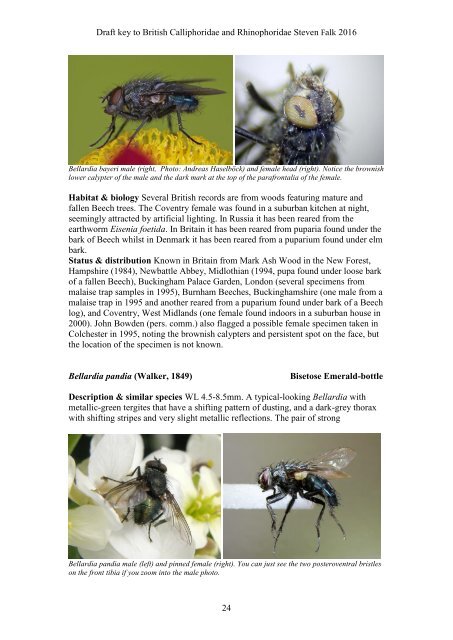BRITISH BLOWFLIES (CALLIPHORIDAE) AND WOODLOUSE FLIES (RHINOPHORIDAE)
4cmTmdCuA
4cmTmdCuA
Create successful ePaper yourself
Turn your PDF publications into a flip-book with our unique Google optimized e-Paper software.
Draft key to British Calliphoridae and Rhinophoridae Steven Falk 2016<br />
Bellardia bayeri male (right, Photo: Andreas Haselböck) and female head (right). Notice the brownish<br />
lower calypter of the male and the dark mark at the top of the parafrontalia of the female.<br />
Habitat & biology Several British records are from woods featuring mature and<br />
fallen Beech trees. The Coventry female was found in a suburban kitchen at night,<br />
seemingly attracted by artificial lighting. In Russia it has been reared from the<br />
earthworm Eisenia foetida. In Britain it has been reared from puparia found under the<br />
bark of Beech whilst in Denmark it has been reared from a puparium found under elm<br />
bark.<br />
Status & distribution Known in Britain from Mark Ash Wood in the New Forest,<br />
Hampshire (1984), Newbattle Abbey, Midlothian (1994, pupa found under loose bark<br />
of a fallen Beech), Buckingham Palace Garden, London (several specimens from<br />
malaise trap samples in 1995), Burnham Beeches, Buckinghamshire (one male from a<br />
malaise trap in 1995 and another reared from a puparium found under bark of a Beech<br />
log), and Coventry, West Midlands (one female found indoors in a suburban house in<br />
2000). John Bowden (pers. comm.) also flagged a possible female specimen taken in<br />
Colchester in 1995, noting the brownish calypters and persistent spot on the face, but<br />
the location of the specimen is not known.<br />
Bellardia pandia (Walker, 1849)<br />
Bisetose Emerald-bottle<br />
Description & similar species WL 4.5-8.5mm. A typical-looking Bellardia with<br />
metallic-green tergites that have a shifting pattern of dusting, and a dark-grey thorax<br />
with shifting stripes and very slight metallic reflections. The pair of strong<br />
Bellardia pandia male (left) and pinned female (right). You can just see the two posteroventral bristles<br />
on the front tibia if you zoom into the male photo.<br />
24


